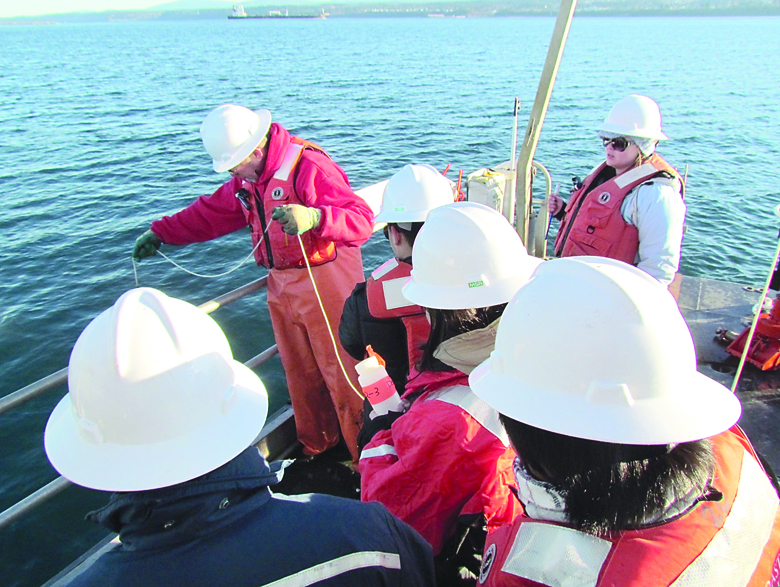PORT ANGELES — A recent bright and cold fall day was one of the few times Corey White has been out in open water on a boat, much less an oceanographic research vessel.
“A lot of people said it would be colder than it actually was,” said White, a 26-year-old Georgia native who started at Peninsula College in September.
White was one of 18 Peninsula College students who bundled up Nov. 22 and set out on the research vessel Tatoosh into Port Angeles Harbor and the surrounding waters.
The goal: give students a chance to see and feel hands-on what it’s like to collect samples of microscopic animals, test water temperature and scrutinize scoops of sediment collected from the harbor bottom.
“[The students] did more or less everything,” said Ian Miller, a seasonal teacher at Peninsula College and the brainchild for the boat trip, taken as part of his fall “Introduction to Oceanography” class.
Tatoosh skipper
Miller, whose day job is as a coastal hazards scientist with Washington Sea Grant, came up with the idea for the class trip after talking with Rick Fletcher, who helps skipper the Olympic Coast National Marine Sanctuary’s Tatoosh.
Miller said a body of educational research has consistently shown that experiential or hands-on education, especially in the ocean sciences, improves student motivation to both learn and want to advance further in the field.
Knowing this, Miller said he worked with sanctuary staff earlier in the fall to determine the nuts and bolts of a class trip using the sanctuary’s research ship, moored in the Port Angeles Boat Haven for the fall and winter.
The entire trip nearly fell victim to the 16-day partial government shutdown in October, Miller said, since the sanctuary offices were forced to close during that time.
“It almost didn’t happen because we weren’t able to plan in that period,” Miller said.
But happened it did, with Fletcher and sanctuary Marine Operations Officer Justin Ellis taking Miller’s students, split into three groups, to pre-determined survey sites on the chilly November day.
“It was a very cold day,” Miller said.
“But you know, [the] students sort of powered through it.”
Each group traveled to three separate sites: two on the western interior of Port Angeles Harbor and one just offshore near the former Rayonier paper mill site.
Students took water samples to measure a number of different attributes, Miller explained, such as salinity, plankton levels and turbidity, or the amount of suspended material in water.
Sediment samples also were taken from the sea bottom with a spring-loaded metal grabber, Miller said, with students combing through the silt to find what organisms lived there.
“For a good number of the students, it was the most animated that I’ve ever seen them,” he said.
“There’s nothing like being on the boat and being in the field to get students to kind of step out a little bit.”
Hands-on work
White said the hands-on work allowed him to gain a better appreciation of the marine environment and its fragility.
He said Miller’s class as a whole has made him more aware of the potential negative effects global climate change could have on coastal ecosystems and what he can do to improve public knowledge about those issues.
“I’m trying to understand my niche, my role, as far as what I can do to help spread the word and the importance of that,” White said.
Robert Steelquist, the sanctuary’s education and outreach coordinator, said opportunities such as Miller’s class trip are key to allowing students to better understand all aspects ocean sciences.
“From my standpoint . . . a day on the water like that exposes students not just to the science of that work but the practical aspects of that work,” Steelquist said.
“We do need mechanics; we need boat operators, as well as oceanographers.”
The sanctuary often teams up with schools of multiple grade levels to expose students to oceanography, though Steelquist said this was the first time sanctuary staff had specifically worked with Miller and his class.
“It really fit well with where Dr. Miller was with his students, and we were really pleased with the outcome,” Steelquist said.
He said the sanctuary likely will consider being a part of similar trips in the future.
“We try to make opportunities available whenever the right combination of circumstances are present,” he said.
“We just look for those opportunities and take advantage when we can, and hopefully, a lot of students benefit.”
Trip deemed success
Miller said he considered the trip a success, based on input from his students.
“If the sanctuary is willing, we’d definitely do it again,” Miller said.
“And if we can find some funding, we’ll expand it.”
For White, the chilly November day out on the water, elbow deep in the rudiments of ocean research, only made him want to continue his education in that field.
“It actually steeled my resolve a little bit,” White said.
_________
Reporter Jeremy Schwartz can be reached at 360-452-2345, ext. 5074, or at jschwartz@peninsuladailynews.com.

